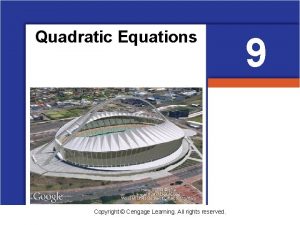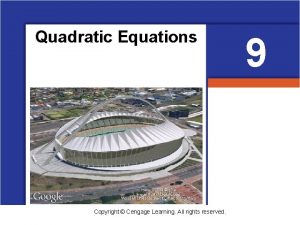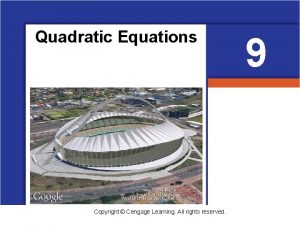Differential Equations Copyright Cengage Learning All rights reserved

























- Slides: 25

Differential Equations Copyright © Cengage Learning. All rights reserved.

1 Slope Fields and Euler’s Method Copyright © Cengage Learning. All rights reserved.

Objectives n Use initial conditions to find particular solutions of differential equations. n Use slope fields to approximate solutions of differential equations. n Use Euler’s Method to approximate solutions of differential equations. 3

General and Particular Solutions 4

General and Particular Solutions Physical phenomena can be described by differential equations. Recall that a differential equation in x and y is an equation that involves x, y, and derivatives of y. For example, A function y = f(x) is called a solution of a differential equation if the equation is satisfied when y and its derivatives are replaced by f(x) and its derivatives. 5

General and Particular Solutions For example, differentiation and substitution would show that y = e– 2 x is a solution of the differential equation y' + 2 y = 0. It can be shown that every solution of this differential equation is of the form y = Ce– 2 x General solution of y ' + 2 y = 0 where C is any real number. This solution is called the general solution. Some differential equations have singular solutions that cannot be written as special cases of the general solution. 6

General and Particular Solutions The order of a differential equation is determined by the highest-order derivative in the equation. For instance, y' = 4 y is a first-order differential equation. The second-order differential equation s''(t) = – 32 has the general solution s(t) = – 16 t 2 + C 1 t + C 2 General solution of s''(t) = – 32 which contains two arbitrary constants. It can be shown that a differential equation of order n has a general solution with n arbitrary constants. 7

Example 1 – Verifying Solutions Determine whether the function is a solution of the differential equation y''– y = 0. a. y = sin x b. y = 4 e–x c. y = Cex Solution: a. Because y = sin x, y' = cos x, and y'' = –sin x, it follows that y'' – y = –sin x – sin x = – 2 sin x ≠ 0. So, y = sin x is not a solution. 8

Example 1 – Solution cont’d b. Because y = 4 e–x, y' = – 4 e–x, and y'' = 4 e–x, it follows that y'' – y = 4 e–x – 4 e–x= 0. So, y = 4 e–x is a solution. c. Because y = Cex, y' = Cex, and y'' = Cex, it follows that y'' – y = Cex – Cex= 0. So, y = Cex is a solution for any value of C. 9

General and Particular Solutions Geometrically, the general solution of a first-order differential equation represents a family of curves known as solution curves, one for each value assigned to the arbitrary constant. For instance, you can verify that every function of the form is a solution of the differential equation xy' + y = 0. 10

General and Particular Solutions Figure 6. 1 shows four of the solution curves corresponding to different values of C. Particular solutions of a differential equation are obtained from initial conditions that give the values of the dependent variable or one of its derivatives for particular values of the independent variable. Figure 6. 1 11

General and Particular Solutions The term “initial condition” stems from the fact that, often in problems involving time, the value of the dependent variable or one of its derivatives is known at the initial time t = 0. For instance, the second-order differential equation s''(t) = – 32 having the general solution s(t) = – 16 t 2 + C 1 t + C 2 General solution of might have the following initial conditions. s(0) = 80, s'(0) = 64 Initial conditions s''(t) = – 32 In this case, the initial conditions yield the particular solution s(t) = – 16 t 2 + 64 t + 80. Particular solution 12

Example 2 – Finding a Particular Solution For the differential equation xy'– 3 y = 0, verify that y = Cx 3 is a solution. Then find the particular solution determined by the initial condition y = 2 when x = – 3. Solution: You know that y = Cx 3 is a solution because y' = 3 Cx 2 and xy'– 3 y = x(3 Cx 2) – 3(Cx 3) = 0. 13

Example 2 – Solution cont’d Furthermore, the initial condition y = 2 when x = – 3 yields y = Cx 3 General solution 2 = C(– 3)3 Substitute initial condition. Solve for C and you can conclude that the particular solution is Particular solution Try checking this solution by substituting for y and y' in the original differential equation. 14

Slope Fields 15

Slope Fields Solving a differential equation analytically can be difficult or even impossible. However, there is a graphical approach you can use to learn a lot about the solution of a differential equation. Consider a differential equation of the form y' = F(x, y) Differential equation where F(x, y) is some expression in x and y. At each point (x, y) in the xy–plane where F is defined, the differential equation determines the slope y' = F(x, y) of the solution at that point. 16

Slope Fields If you draw short line segments with slope F(x, y) at selected points (x, y) in the domain of F, then these line segments form a slope field, or a direction field, for the differential equation y' = F(x, y). Each line segment has the same slope as the solution curve through that point. A slope field shows the general shape of all the solutions and can be helpful in getting a visual perspective of the directions of the solutions of a differential equation. 17

Example 3 – Sketching a Slope Field Sketch a slope field for the differential equation y' = x – y for the points (– 1, 1), (0, 1), and (1, 1). Solution: The slope of the solution curve at any point (x, y) is F (x, y) = x – y. So, the slope at (– 1, 1) is y' = – 1 = – 2, the slope at (0, 1) is y' = 0 – 1 = – 1, and the slope at (1, 1) is y' = 1 – 1 = 0. 18

Example 3 – Solution cont’d Draw short line segments at the three points with their respective slopes, as shown in Figure 6. 2 19

Euler’s Method 20

Euler’s Method is a numerical approach to approximating the particular solution of the differential equation y' = F(x, y) that passes through the point (x 0, y 0). From the given information, you know that the graph of the solution passes through the point (x 0, y 0) and has a slope of F(x 0, y 0) at this point. This gives you a “starting point” for approximating the solution. 21

Euler’s Method From this starting point, you can proceed in the direction indicated by the slope. Using a small step h, move along the tangent line until you arrive at the point (x 1, y 1) where x 1 = x 0 + h and y 1 = y 0 + h. F(x 0, y 0) as shown in Figure 6. 5 22

Euler’s Method Then, using (x 1, y 1) as a new starting point, you can repeat the process to obtain a second point (x 2, y 2). The values of xi and yi are as follows. When using this method, note that you can obtain better approximations of the exact solution by choosing smaller and smaller step sizes. 23

Example 6 – Approximating a Solution Using Euler’s Method Use Euler’s Method to approximate the particular solution of the differential equation y' = x – y passing through the point (0, 1). Use a step of h = 0. 1. Solution: Using h = 0. 1, x 0 = 0, y 0 = 1, and F(x, y) = x – y, you have x 0 = 0, x 1 = 0. 1, x 2 = 0. 2, x 3 = 0. 3, …, and y 1 = y 0 + h. F(x 0, y 0) = 1 + (0. 1)(0 – 1) = 0. 9 y 2 = y 1 + h. F(x 1, y 1) = 0. 9 + (0. 1)(0. 1 – 0. 9) = 0. 82 y 3 = y 2 + h. F(x 2, y 2) = 0. 82 + (0. 1)(0. 2 – 0. 82) = 0. 758. 24

Example 6 – Solution cont’d The first ten approximations are shown in the table. You can plot these values to see a graph of the approximate solution, as shown in Figure 6. 6 25
 Copyright 2015 all rights reserved
Copyright 2015 all rights reserved Copyright © 2015 all rights reserved
Copyright © 2015 all rights reserved Dell all rights reserved copyright 2009
Dell all rights reserved copyright 2009 Copyright © 2018 all rights reserved
Copyright © 2018 all rights reserved Cengage differential equations
Cengage differential equations Separation of variables differential equations
Separation of variables differential equations Copyright cengage learning. powered by cognero
Copyright cengage learning. powered by cognero All rights reserved example
All rights reserved example All rights reserved sentence
All rights reserved sentence Freesound content licence
Freesound content licence Confidential all rights reserved
Confidential all rights reserved All rights reserved example
All rights reserved example 2012 pearson education inc
2012 pearson education inc Microsoft corporation. all rights reserved.
Microsoft corporation. all rights reserved. Microsoft corporation. all rights reserved.
Microsoft corporation. all rights reserved. Microsoft corporation. all rights reserved
Microsoft corporation. all rights reserved Pearson education inc. all rights reserved
Pearson education inc. all rights reserved Warning all rights reserved
Warning all rights reserved All rights reserved c
All rights reserved c Quadratic equation cengage
Quadratic equation cengage Warning all rights reserved
Warning all rights reserved Confidential all rights reserved
Confidential all rights reserved Microsoft corporation. all rights reserved
Microsoft corporation. all rights reserved Pearson education inc. all rights reserved
Pearson education inc. all rights reserved Gssllc
Gssllc Pearson education inc all rights reserved
Pearson education inc all rights reserved















































